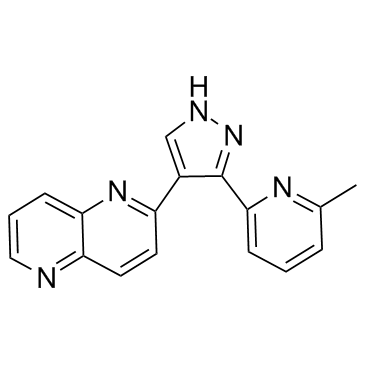
RepSox
CAS No. 446859-33-2
RepSox ( E-616452 | SJN 2511 | E616452 | SJN2511 | E 616452 | SJN-2511 )
产品货号. M14530 CAS No. 446859-33-2
RepSox (E-616452, SJN-2511) 是一种有效的选择性 TGF-β I 型受体 ALK5 抑制剂,Ki 为 25 nM。
纯度: >98% (HPLC)
 COA
COA
 Datasheet
Datasheet
 HNMR
HNMR
 HPLC
HPLC
 MSDS
MSDS
 Handing Instructions
Handing Instructions
| 规格 | 价格/人民币 | 库存 | 数量 |
| 2MG | ¥308 | 有现货 |


|
| 5MG | ¥494 | 有现货 |


|
| 10MG | ¥624 | 有现货 |


|
| 25MG | ¥1288 | 有现货 |


|
| 100MG | ¥3969 | 有现货 |


|
| 200MG | 获取报价 | 有现货 |


|
| 500MG | 获取报价 | 有现货 |


|
| 1G | 获取报价 | 有现货 |


|
生物学信息
-
产品名称RepSox
-
注意事项本公司产品仅用于科研实验,不得用于人体或动物的临床与诊断
-
产品简述RepSox (E-616452, SJN-2511) 是一种有效的选择性 TGF-β I 型受体 ALK5 抑制剂,Ki 为 25 nM。
-
产品描述RepSox (E-616452, SJN-2511) is a potent, selective inhibitor of TGF-β type I receptor ALK5 with Ki of 25 nM, inhibits ALK5 autophosphorylation with IC50 of 4 nM, can replace the central reprogramming factor Sox2 by inducing nanog; specifically acts by inhibiting Tgf-β signaling, does not act by inducing Sox2 expression in the target fibroblasts; efficiently replaces transgenic Sox2 in the absence of VPA and c-Myc, as well as in both embryonic and adult fibroblasts; demonstrates effectivity at generating iPSCs.
-
体外实验RepSox (GMP) (10 μM) induces MEFs differentiating to chemically induced pluripotent stem cells (CiPSCs).RepSox (GMP) (10 μM, in stage I-Stage III induction medium) induces hCiPS cells from HEFs.RepSox (GMP) together with Forskolin (HY-15371) increases the number of proliferative cells in MEFs expressing MyoD, confirmed by increased EdU incorporation.
-
体内实验——
-
同义词E-616452 | SJN 2511 | E616452 | SJN2511 | E 616452 | SJN-2511
-
通路TGF-beta/Smad
-
靶点TGFBR
-
受体ALK5|TGFβR1
-
研究领域Cancer
-
适应症——
化学信息
-
CAS Number446859-33-2
-
分子量287.3186
-
分子式C17H13N5
-
纯度>98% (HPLC)
-
溶解度DMSO: ≥ 52 mg/mL
-
SMILESCC1=CC=CC(C2=NNC=C2C3=NC4=CC=CN=C4C=C3)=N1
-
化学全称2-(3-(6-methylpyridin-2-yl)-1H-pyrazol-4-yl)-1,5-naphthyridine
运输与储存
-
储存条件(-20℃)
-
运输条件With Ice Pack
-
稳定性≥ 2 years
参考文献
1. Ichida JK, et al. Cell Stem Cell. 2009 Nov 6;5(5):491-503.
2. Liu X, et al. Nat Cell Biol. 2013 Jul;15(7):829-38.
3. Gellibert F, et al. J Med Chem. 2004 Aug 26;47(18):4494-506.
4. Wu MZ, et al. Cell Res. 2014 Jun;24(6):641-2.
产品手册




关联产品
-
Kartogenin
Kartogenin 是 smad4/smad5 通路的激活剂,促进多能间充质干细胞选择性分化为软骨细胞。
-
Pentabromophenol
五溴苯酚通过加速 TGF-β 受体的周转率来抑制 TGF-β 反应。
-
A 83-01
一种有效的选择性 TGF-β I 型受体 ALK-5、ALK-4 和 ALK-7 抑制剂,IC50 分别为 12、45 和 7.5 nM。



 021-51111890
021-51111890 购物车()
购物车()
 sales@molnova.cn
sales@molnova.cn







